Get Great Sound: Custom Speaker Design
From Design and Prototyping to Testing and Manufacturing
Getting quality sound from a loudspeaker or loudspeaker system is a mix of art and science. It helps to work with speaker experts, especially if you are embedding speakers into another product (e.g. a car, train, plane, kiosk, ultrasound machine, or casino game). The best speaker manufacturers have audio design engineers with both the technical expertise and the creativity to help you solve any challenge.
This guide includes everything you need to know to arrive at an audio solution that meets your acoustical needs and fits within your budget and timeline. The guide will cover three large topics:
- The application considerations for designing sound systems. This includes where speakers will be used, how big they can be, and how they’ll be housed.
- Speaker specs that matter. Understanding things like impedance, power ratings, sensitivity, frequency, and distortion can help you get the audio solution you want. This also includes selecting amplifiers and incorporating digital sound processing (DSP) into your system.
- The design, prototyping, manufacturing, and testing stages of creating a quality speaker. Learn what questions to ask before you partner with a manufacturer.
The information below reflects more than seven decades of experience MISCO has in creating custom solutions in sound. If you have a unique audio challenge or need precision testing done, we’d be happy to have a conversation with you. We hope you find this guide useful. If you want to dive deeper into the science yourself, download the Loudspeaker 101 Guide.
Don’t have time to read it now?
Email it to yourself.
Designing a Loudspeaker System
There are so many components to quality sound systems (i.e. the materials, the mounting, the powering, the DSP, etc.) that it’s important to take a holistic approach and consider many things at once from the beginning. Communicating your goals and limitations early in the process will make it easier to weigh possible tradeoffs that have to be made around size, price, performance, and timing.
Application Considerations
You will start the process by discussing with your manufacturer how your speakers or sound system will ultimately be used. That will inform where the design process begins in terms of selecting materials and sizing the speakers so you can achieve the sound quality you want.
A big consideration is the environmental conditions the speakers will be exposed to when they are in operation. Will it be indoors or outdoors? Is rain or other moisture going to be present? Many speaker cones are still made out of specially engineered forms of paper because they are lightweight but stiff enough to reproduce soundwaves accurately. If they are to be used outdoors they will need to be impregnated with proven water-resistant treatment.
Knowing the environment will inform decisions around materials for the cone, the grille in front of it (if one is required), the driver inside the speaker, and the enclosure.
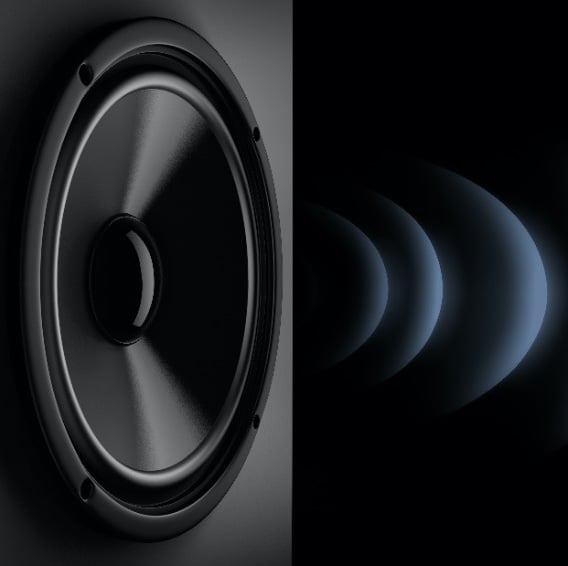
How Loud Does Your Loudspeaker Really Need to Be?
Knowing how loud you need your speakers and which sounds they will be reproducing is also critical information to consider before any design begins. This will directly impact the speaker size and powering requirements of your system.
Sound pressure level (think volume) is expressed on a log scale in dB SPL (decibel sound pressure level). One decibel is the smallest perceptible change in sound level that the human ear can detect.

Some examples of sound pressure levels are:
- Near total silence - 0 dB SPL
- A whisper - 15 dB SPL
- Normal conversation - 60 dB SPL
- A lawnmower - 90 dB SPL
- Passing subway train – 100 dB SPL
- A car horn - 110 dB SPL
- A rock concert or a jet engine - 120 dB SPL (this is about the threshold for pain)
- A gunshot or firecracker - 140 dB SPL
Ideally you want to work with an engineering team and manufacturer who has experience in your particular industry because they will be aware of common requirements, challenges, and how to overcome them to get you the quality and volume you’re looking for.
Size Matters
Odds are you don’t have infinite space for the speakers you want. The dimensions for where your speaker(s) must fit are critical details. The diameter, depth, and any necessary weight limitations you must work within inform selections around the materials your speakers will be made from.
The trend in audio is to expect ever-better sound from ever-smaller speakers. There are physical limitations to how small a speaker can be and still accurately reproduce sounds, but mini speakers have come a long way. You can now get an excellent wide range speaker that sounds great and is less than 20 mm in diameter.
Depending upon the application for your system, a single full range speaker may not be the best solution. Speakers sound best when they are handling the frequencies they were designed and built for (more on this below). A little background on the types of speakers is helpful here.
Woofer
A woofer reproduces low frequencies best, below 150 Hz. A woofer will almost always be 5" or larger. Smaller ones can be designed to fit into compact systems. A woofer requires a larger excursion capability in its design (more cone travel). Some may travel as much as 25 mm.
Midrange
A midrange driver is optimal for sounds around 100 Hz up to 4 kHz or 5 kHz. They are typically 2.25” to 5” in diameter. These require less excursion space than a woofer but must have frequency responses that are free of irregularities in their frequency band.
Tweeter
A tweeter is smaller and intended only for higher frequencies, usually 2 kHz to 20 kHz. It will have very little diaphragm motion, but must be very light in order to reproduce high frequencies. Tweeters come in different sizes and diaphragm types (cone, horn, dome, and electrostatic).
Incorporating two separate types of speakers in a system (e.g. a midrange and a tweeter) is an effective way to improve the overall sound quality. Another option is a coaxial speaker design. These are essentially two speakers in one, typically with a tweeter built into the middle of a woofer.
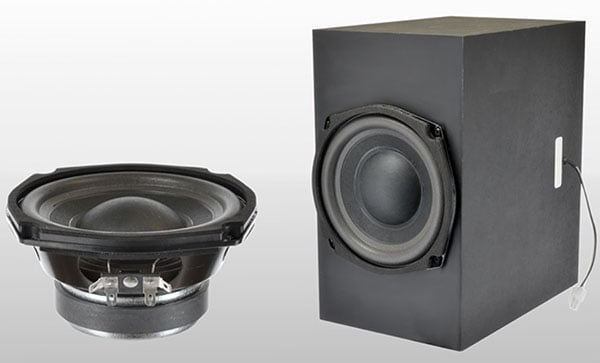
Speaker Cabinet / Speaker Enclosure
You may or may not have control over how and where your speakers are housed. They may have to fit into a very specific space in a car door or piece of equipment. However, it is important to understand that a speaker’s enclosure type and the materials it is made from impact durability, sound quality, and can be part of the engineering process to get the specific sound you are looking for.
Enclosures typically fit one of three categories: sealed, ported, or passive radiator.
Sealed
A sealed enclosure affects the movement of the cone at low frequencies by acting as an air spring. Because it is helping tune the sounds at low frequencies, a sealed enclosure must be built airtight. If it is large enough relative to the speaker, it is considered an infinite baffle and has minimal effect on the low frequency of the speaker; if the enclosure is too small, it will raise the resonant frequency of the speaker and limit low frequency performance.
Ported
A ported speaker enclosure (or vented, or bass reflex) has a ported tube. It may have to be larger to accommodate the tube, but by adjusting the size and length, audio engineers can tune the box to a specific resonant frequency, to improve low frequency response of a speaker.
Passive radiator
A passive radiator (sometimes referred to as a "drone cone") assists the low frequency performance of a speaker, and does not have a magnetic motor assembly or voice coil. Passive radiators can achieve comparable tuning to ported boxes but take up less space. They're ideal for shallow home audio and car audio applications where there is not enough room for a long port.
Grilles
Another consideration is how the grille or baffle of your speaker will affect the sound. A grille can inhibit high frequency performance if the apertures are too small, while the baffle (face of the cabinet that the speaker is mounted on) can add gain to midrange frequencies between 800 Hz to 6 kHz depending on its size. With advanced simulation testing this can be accounted for and adjusted via DSP.
Speaker Specs
When designing a loudspeaker or sound system, always consider the speaker specifications.
Nominal impedance is nominal electrical resistance the speaker presents to an amplifier. It is measured in Ohms. Most speakers are rated at 4, 6, 8, or 16 Ohms (8 is the most common). The lower the impedance, the more electrical current a speaker draws from the amplifier. Think of it as the size of the load put on the amp.
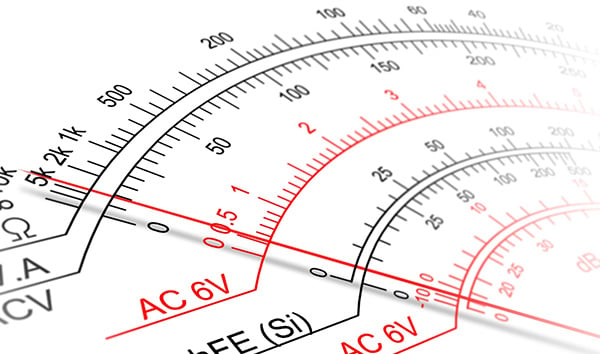
If you wire more than one speaker in parallel it reduces the total impedance. The equation to calculate it is very simple:

So two 8 Ohms speakers wired in parallel actually have a 4 Ohm load. Impedance characteristics are also important in the design of multi-speaker (2-way, 3-way, or more) systems. It is a bit deceiving that impedance is given as a single number. Because impedance varies with frequency, its best to look at an impedance curve to know what the impedance will be any frequency. Speaker manufacturers can incorporate impedance adjustments into designs in order to get more power out of an amplifier and more volume out of a speaker.
Power Ratings
Ever blown a loudspeaker? Then you’ve learned about power ratings—the theoretical limit manufacturers give speakers. A massive arena speaker could be rated for thousands of watts or a small one in a phone could be under 1W.
The power rating generally grows with the size of the speaker and the voice coil. It speaks to durability, reliability, and at what point the speaker won’t perform well.
However, there is no one standard way to establish a speaker’s power rating.
Unfortunately, marketing departments can make wattage as a top selling point and exaggerate it. The term “marketing watts” gets used derogatorily when it is clear to engineers that the power handling of the speaker is overstated.
There are three common industry groups that set power rating standards.
- AES2-1984 (the Audio Engineering Society)
- EIA-426B (the Electronic Industries Alliance)
- IEC 60027 (the International Electrotechnical Commission)
Different manufacturers use different standards (MISCO uses EIA-426B, one of the most widely-used ones in the industry). A good manufacturer will be able to explain what their rating means in relation to your audio project. Be sure you ask.
Sensitivity
Sensitivity measures the relationship between wattage in and volume out (at a specific distance). The standard for reporting sensitivity is to give the dB SPL at one meter away from the speaker when one watt of power, or 2.83V, is fed into it. Sensitivity is often proportional to the size of a driver and must be considered as such. For example, a sensitivity below 84 dB is very low for an 8” speaker, but considered very good for a 2" speaker.
Sensitivity ratings come into play when deciding what kind of amplifier you may need in order to properly power your system. You can increase a speaker’s sensitivity by making a cone out of a lighter material or increasing the drive force of the magnet. However, it’s a careful dance because the lighter material may not give you the sound-quality characteristics you want.
Frequency response
Frequency response helps tell you how well a speaker reproduces the bass, midrange, and treble being fed into it. It can let you know if the speaker is accentuating or diminishing any of those frequencies.
A frequency response graph, also known as a chart or curve, will show frequency measured in Hz/kHz on the X-axis and amplitude measured in dB SPL on the Y-axis. The graph for a woofer will look very different from that of a tweeter.
Resonant frequency
This tells you the lowest frequencies a speaker will function well at. It’s impacted by the materials and design of the cone and the speaker’s driver. In general, if your speaker will be handling lower tones you’ll want a lower resonant frequency. This number also comes into play when considering enclosures and whether they may “ring” at the frequencies below the resonant frequency of the speaker.
WOOFER
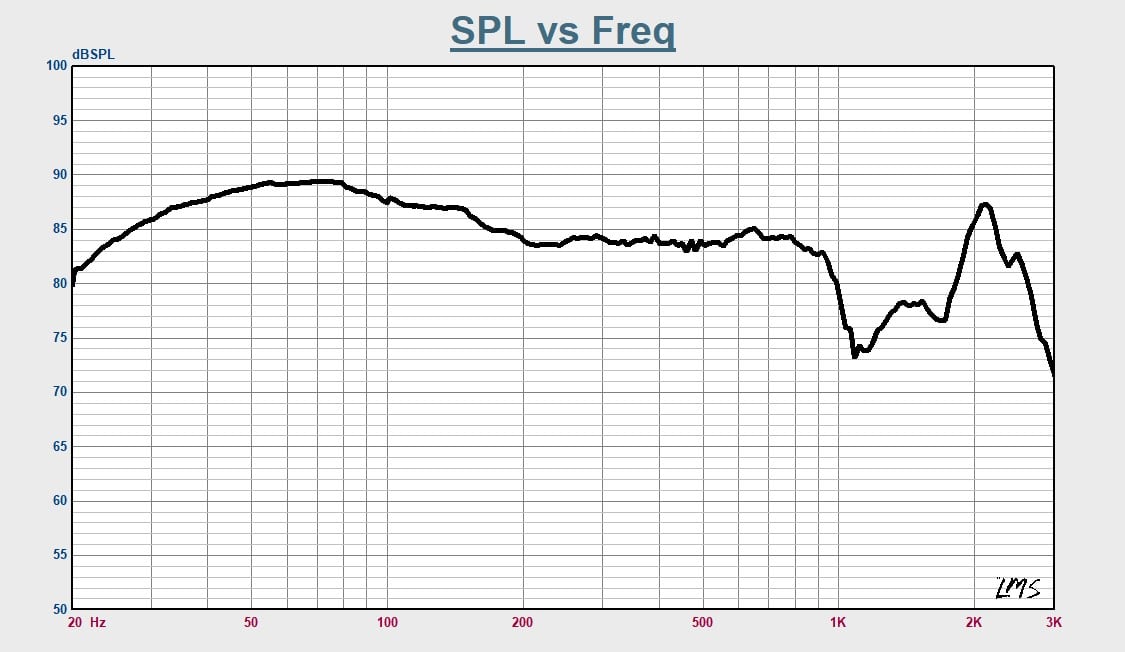
TWEETER
.jpg)
There is no perfect frequency response. The perfect scenario is your speaker is designed and built to perform best at the frequency it will be used for. Understanding this, you can start to weigh decisions like: Do I need a full range speaker or a midrange speaker?
Distortion is any unintended change of the signal going into a system. This could be in the electrical signal feeding into a speaker or the speaker imparting its own characteristics onto the signal. Distortion is either linear or nonlinear.
Linear distortion refers to changes in the amplitude (volume) of the signal and relates to the frequency response. Typically, this can be fixed with digital signal processing (DSP).
Nonlinear distortion is when extra frequencies are produced that aren’t intended. It is classified as either harmonic or intermodulation distortion.
Harmonic distortion is when a fundamental signal at one frequency is reproduced by a speaker in multiples, or harmonics, at higher frequencies. It’s measured in dB (just like normal amplitude).
Total harmonic distortion (THD) is a percentage of how dramatic the distortion is compared to the original signal (with each order of harmonics contributing to the percentage). Too much THD is bad and easy to hear on a cheaply made speaker.
The biggest contributors to THD are the mechanical components of a speaker (i.e. magnet, cone, surround, voice coil, etc). The amount of harmonic distortion that is acceptable is heavily dependent on the intended application for a speaker. You can use advanced testing tools like Klippel QC and SoundCheck by Listen, Inc. to get really detailed insights into THD and its causes.
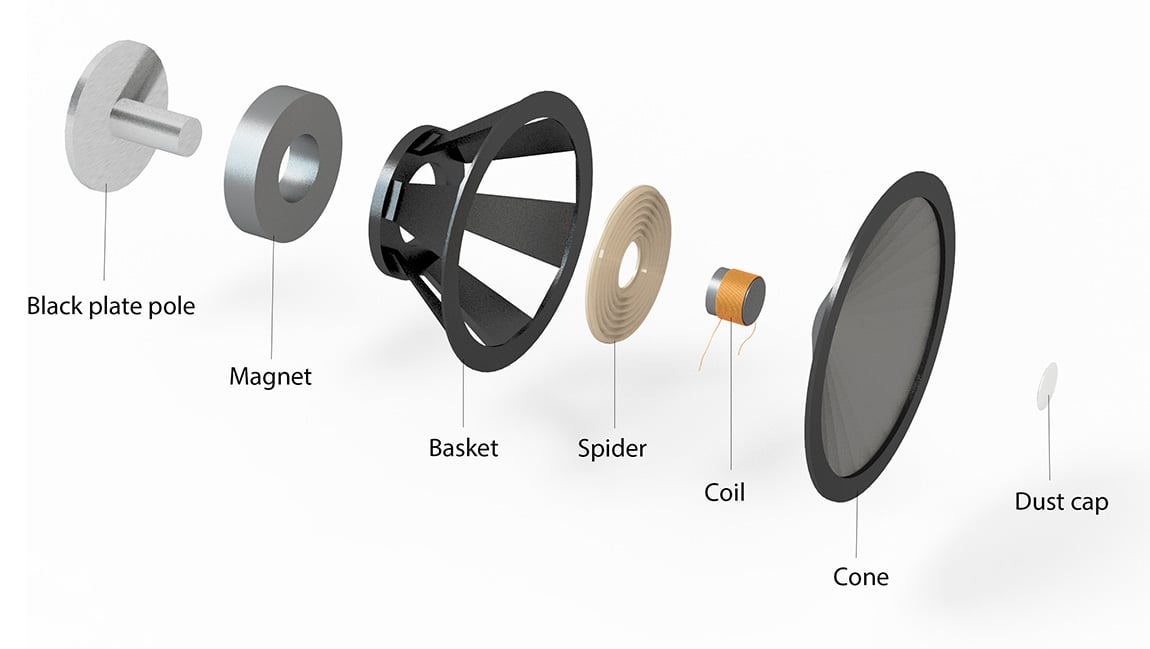
Intermodulation distortion is when two (or more) signals mix. This can affect amplitudes and create new frequencies that were not in the original signal. These are sometimes called sidebands.
Not all distortion is bad. Take guitars for example, they sound cool, in part, because they have a unique “fuzzy” sound which is a form of distortion, and guitar speakers are built specially to handle this.
Amplifiers and DSP
To get the best performance from your system, it needs to have the right amplifier which can be enhanced by the integration of DSP. The DSP technology has been around for about 30 years. It gives audio engineers a powerful tool to correct room/deployment space issues or to integrate tools such as crossovers or equalization instead of having separate hardware. One tiny DSP chip can handle compression, time delays, crossovers, and equalization, among other functions. The DSP can flatten out peaks and dips in the frequency response of a system that may occur after the audio system is built. It can also help ensure uniformity because all the DSP settings in a system can be pre-configured to match. Although DSP is a powerful tool it can't compensate for a poorly made speaker—that's the starting point for any good audio system.
Coupled with rigorous testing processes, DSP can lower manufacturing costs, too. For instance, you can use DSP to monitor the break point of a transducer or woofer, so you can maximize or control excursion while reducing the required enclosure size for a speaker. Or save the cost of an expensive crossover network.
Make sure you work with a manufacturer willing to provide you with the DSP configuration file or the GUI you need to create one (not all of them will). This allows you to make your own adjustments in the future.
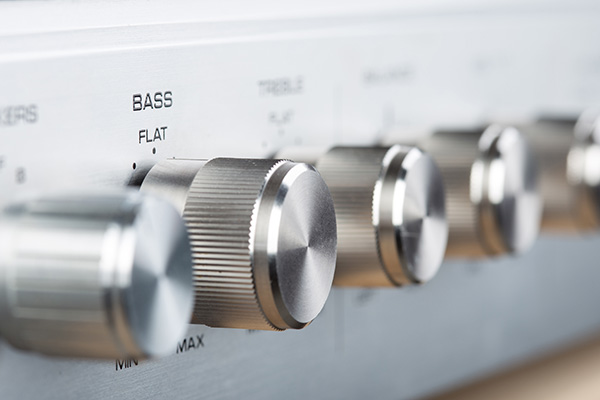
Selecting an Amp
Electronic advancements have reshaped amplifiers in recent decades. The first amps invented (Class A, Class B, and Class AB) used vacuum tubes or transistors that most always stayed on. This is very inefficient and produces unnecessary heat due to the wasted power not sent to speakers. Today’s Class D amps operate like a digital switch (with the components turning on and off extremely fast). This is much more efficient, produces less heat, and allows for smaller amps that last longer.
A good rule of thumb is you need an amp that can supply double the power a speaker is rated for during its normal usage. This leaves enough “head room” for the amp when the speaker is at full volume. During a speaker’s normal operations, you want an amp working at 60% or less capacity. This prevents the amplifier from going into "clipping" during demanding moments from the program material (such as heavy bass passages).
Selecting an amp requires knowing how many speakers will be connected. Most all of MISCO's amplifiers are 4-ohm stable, which means you can connect speakers with 4-ohm and higher impedance to each channel. The higher the impedance of the speaker, the less power will be delivered by the amplifier.
Amps come in mono (with one output), stereo (two outputs), and multichannel (more than two outputs). A mono amp may be right for something like a PA system. Stereo amps are common in hi-fi systems or headphones - where you’re feeding a right and left speaker. Multi-channel amps are used in surround sound systems and bi-amp applications where you have different kinds of speakers (tweeter and woofer with electronic crossover and DSP) working in tandem.
Speaker Design, Production, and Testing
Once your system specs have been determined, you can move to design, prototyping, and testing. Again, taking a holistic approach to your system will help get you better results because design engineers may be able to suggest adjustments that could save you money early on in the process. You can lean on their expertise to decide which components of your system are the ones worth investing in.
The engineers will help create drawings and a bill of materials (BOM) – the list of all the parts (both custom and "off-the-shelf") that will go into your system. Using the drawings and BOM, you can start to get quotes both for samples and for the finished products. It’s important to get functional prototypes because even the best modeling won’t tell you exactly how an audio system will perform. Thanks to advancements in 3D printing and computer numerical control (CNC) routers, prototypes of drivers and enclosures can be made faster than ever.
Speaker Testing
Historically, testing a speaker used to require an anechoic chamber and several weeks of precise measurements. Now this work can be accomplished by high-tech Klippel technology in just a matter of hours.
Working with testing experts means the iterative process towards a finished product can go faster. Plus, you will have greater assurances around consistency of quality. These are the tests that will give you a good idea of how your speakers or full system will perform.
- Klippel automated Life Test to measure power handling for both long-term and short-term durability and reliability.
- LPM (Small Signal measurements) and LSI (Large Signal measurements) modules which measure linear, non-linear, and thermal parameters and 3D displacement as well as complete distortion testing.
- Suspension Part Measurement (SPM) to measure the cone surround and a spider’s linear, and non-linear movements. Material Parameter Measurements (MPM) include information such as Young's Modulus(e), which is a measurement describing a material's elasticity.
- Laser Scanning Vibrometer (SCN) to visualize the vibrational and acoustical behavior of cones, transducers, enclosures, baffles, and other speaker parts throughout the audio range.
Your manufacturer can also supply you with a sample speaker so you can test it in the environment or end product that it will be used in.
Speaker Manufacturing
There are several questions you should ask a speaker manufacturer before you select them to make your product. Their answers should help you feel more comfortable that you have a trusted partner in the process. The questions include:
- What experience does your company have with our industry?
- How do you organize and execute the design process?
- What testing capabilities do you have?
- What are the options for manufacturing locations?
- How do you handle quality control?
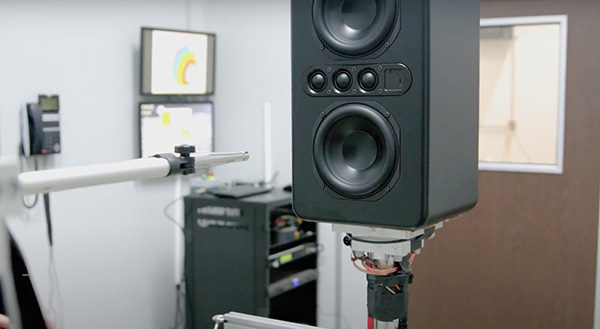
The flexibility to do manufacturing in Asia or America will allow you to make the right decision for your company based on costs, timelines, and protecting your intellectual property.
Wherever you decide to do your manufacturing, make sure the factory can offer extensive and thorough end-of-line testing on every unit.his is the ultimate quality control check to ensure the product you approved, is the product you receive in every shipment. Many manufacturers do minimal checks to ensure the speaker operates but ignores critical parameters like resonant frequency, frequency response, sensitivity, Qts and distortions.
A Good Partner Makes Better Custom Audio Solutions
Ultimately, you need to feel comfortable and confident with the people you work with on your audio system. Start the conversation by explaining your needs and asking questions. Take note of how your potential partner is listening to your needs, budget, and timeline. The best audio design engineers will listen, provide technical expertise, and add just the right amount of creativity to help you solve any unique challenge.